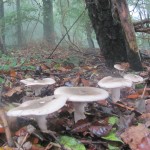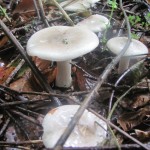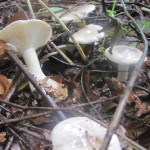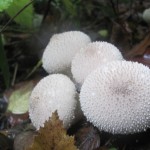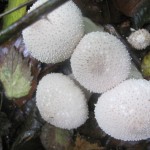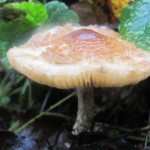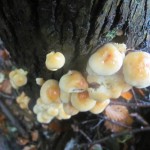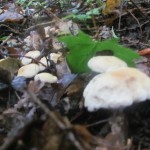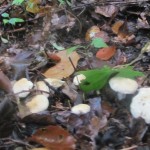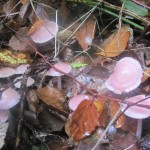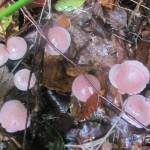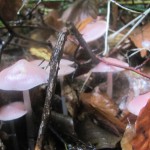A hunt around a mixed species wood in north-west Kent. I know it best for the Wood Blewits that grow there, hunkering under the brambles. Last year I went there in late autumn and apart from Blewits I also found, to my surprise, a good number of Ceps. That time of year the Blewits were fresh, but many of the Ceps were past their best. It was wonderful to find a new Cep residence, and this year I went back in mid-October…, and of Ceps there were none…, and of Blewits there were none. Calamity! Either a hunter who knows this wood had been there just before me, or the weather was wrong, or the Ceps had finished and the Blewits were yet to come. Who knows?
Actually it was a poor haul in general. Lots of Clouded Agaric (very common, said to be edible but a bit dodgy and I’ve never risked it), a handful of Common Puffballs (edible when young), and a pretty looking Girdled Dapperling (unknown edibility), I spent a couple of hours finding very little, but was determined to make one good find that day. I strayed into a part of the wood that I know less well, and then success! A good scattering of Wood Hedgehogs. The book says they’re fairly common but it was a first for me. Of course it was obvious what they were as soon as I turned one over, with the tiny spines instead of gills. And very tasty too. I combined them with the puffballs into a mushroom pate. (Recipe from River Cottage Handbook – Mushrooms: Basically ½ lb of mushrooms, plus a good few cloves of garlic, salt and pepper, all fried in butter. Blitz the mixture then add ½ lb cream cheese and blitz again.) I also found some mysterious pink things. Still not sure what they are – need to do some research.
This was my first time with a camera on a mushroom hunt so the images are not so fantastic; the white has flared out a bit. (Major new job – read the camera manual!)

